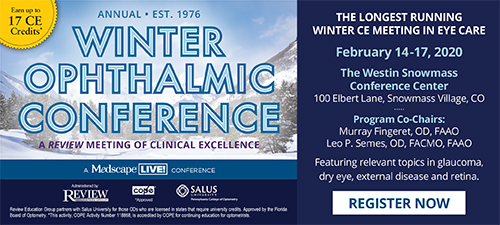
A
weekly e-journal by Art Epstein, OD, FAAO
Off the Cuff: Red Herring
Making a diagnosis is much like following a road map and not knowing where you are going until you get there. This past weekend, I was reminded of just how easy it is to get lost along the way. The patient, a young woman who called in as an emergency on a typically busy Saturday morning said she suffered from recurrent corneal erosions and had a really bad one upon waking that morning. When she arrived at the office, luck of the draw put her in my chair. Our rule is whoever is free or has the lightest schedule gets the emergency. Although I see dry eye and ocular surface disease almost exclusively, I do enjoy the unpredictability, urgency and change of pace of a good emergency visit. And this was a good one. Our tech did her best to work the patient up, but pain and light sensitivity limited what she could do. The exam room was dark. I thought to myself this was typical of an unhappy cornea, as I walked in. The patient shared that she had had several past episodes much like this one and had been diagnosed with recurrent erosions. She said this one was so bad it was making her feel nauseous. I thought that was a bit odd, but gently pried her eye open to take a quick look before I instilled a drop of topical anesthetic. It made her feel better, but not that much. I again thought this was unusual, but guided the slit lamp into place. Instead of the large abrasion I expected, her cornea was a swollen edematous mess with bullae evident in the periphery. The edema was bad enough to obscure anterior chamber details. This was definitely not a typical abrasion, I thought. Then again, I’ve seen serious erosions and corneas that were in bad shape, but something really bothered me about this one. As I mulled it over, Shannon popped her head in, and I asked her to take a look. I was perplexed, and I’ve learned that two heads are always better than one, especially when the other one is my very smart wife’s. We discussed the case, reviewed the history and the findings. As I started talking about how to treat this, Shannon asked a simple question: What were her pressures? It took but an instant for me to realize that the history of recurrent erosion was a red herring. The patient was in the midst of a narrow-angle attack and probably not for the first time. Her recurrent erosions were likely misdiagnosed. I was so fixated on her prior history, I initially missed the obvious. Although I was annoyed at myself for not seeing it immediately, I was thankful that my clinical intuition kept me out of trouble. The patient’s mid 60s IOPs were quickly brought down and she was sent for an emergency LPI. Lesson learned. Red herrings do not make for a tasty meal.
|
|||||
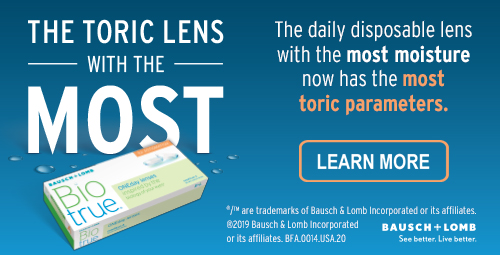 |
||
| Novel Polyvinyl Pyrrolidone-loaded Olopatadine HCL Laden Doughnut Contact Lens to Treat Allergic Conjunctivitis | ||||
Olopatadine HCl is an anti-allergy drug used for the management of allergic conjunctivitis. Currently, it is delivered via an eye drop solution, which is highly inefficient due to low bioavailability. Silicone contact lenses can be used to sustain the release of ophthalmic drugs. However, the presence of drugs alters the optical transmittance and physical properties of the contact lens. The objective was to design a novel PVP (polyvinyl pyrrolidone)-coated olopatadine-ethyl cellulose microparticles laden doughnut contact lens to sustained ocular delivery with limited alteration to the optical and swelling properties of the contact lens. The doughnut was implanted within the periphery of the lens using a modified casting technique. Olopatadine HCl was loaded by soaking (SM-OL), direct loading (DL-OL) and the doughnut casting method (DNT-OL). PVP (comfort agent) was loaded on the surface of contact lens for all the batches via a novel curing technique. The in vitro olopatadine HCl release data of SM-OL (up to 48 to 72 hours) and DL-OL batches (up to 72 hours) showed high-burst release, while the DNT-OL batch showed sustained release up to 120 hours without significant (p>0.05) alteration in the optical and swelling properties of the contact lens. All the batches showed sustained release of PVP up to 120 hours. The in vivo studies in the rabbit tear fluid showed improvement in the olopatadine HCl and PVP retention time in comparison to eye drop solution. The PVP-loaded DNT-OL-500 lens showed tear stabilization (comfort wear) in Schirmer’s strip tests (rabbits) with no protein adherence in comparison to the DNT-OL-500 lens without PVP. The study demonstrated the successful delivery of olopatadine HCl and PVP-K30 from the doughnut contact lens for the extended period of time with limited alteration to the optical and swelling properties of contact lens.
|
||||
SOURCE: Xue Y, Zhang W, Lei Y, et al. Novel polyvinyl pyrrolidone loaded olopatadine HCl laden doughnut contact lens to treat allergic conjunctivitis. J Pharm Sci. 2020; Jan 30. [Epub ahead of print]. |
||||
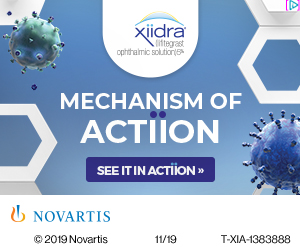 |
||
| Efficacy of Repeat Selective Laser Trabeculoplasty in Medication-Naive Open-Angle Glaucoma and Ocular Hypertension during the LiGHT Trial | ||||
These researchers evaluated the efficacy of repeat selective laser trabeculoplasty (SLT) in medication-naive open-angle glaucoma (OAG) and ocular hypertensive (OHT) patients requiring repeat treatment for early to medium-term failure during the Laser in Glaucoma and Ocular Hypertension (LiGHT) trial, as part of a post hoc analysis of the SLT treatment arm of a multicenter, prospective, randomized controlled trial. Included were participants with treatment-naive OAG or OHT requiring repeat 360-degree SLT within 18 months. Retreatment was triggered by predefined IOP and disease-progression criteria (using objective individualized target IOPs). After SLT at baseline, patients were followed for a minimum of 18 months after a second (repeat) SLT. A mixed-model analysis was performed with the eye as the unit of analysis, with crossed random effects to adjust for correlation between fellow eyes and repeated measures within eyes. Kaplan-Meier curves helped plot the duration of effect. Main outcome measures were initial (early) IOP lowering at two months, and duration of effect after initial and repeat SLT. A total of 115 eyes of 90 patients received repeat SLT during the first 18 months of the trial. Pretreatment IOP before initial SLT was significantly higher than before retreatment IOP of repeat SLT. Absolute IOP reduction at two months was greater after initial SLT compared with repeat SLT. Adjusted absolute IOP reduction at two months (adjusting for IOP before initial or repeat laser) was greater after repeat SLT. A total of 34 eyes were early failures (retreatment two months after initial SLT) vs. 81 later failures (retreatment >2 months after initial SLT). No significant difference in early absolute IOP reduction at two months after repeat SLT was noted between early and later failures. Repeat SLT maintained drop-free IOP control in 67% of 115 eyes at 18 months, with no clinically relevant adverse events. These exploratory analyses demonstrated that repeat SLT could maintain IOP at or below target IOP in medication-naive OAG and OHT eyes requiring retreatment with at least an equivalent duration of effect to initial laser. |
||||
SOURCE: Garg A, Vickerstaff V, Nathwani N, et al. Laser in Glaucoma and Ocular Hypertension Trial Study Group. Efficacy of repeat selective laser trabeculoplasty in medication-naive open-angle glaucoma and ocular hypertension during the LiGHT Trial. Ophthalmology. 2019; Oct 30. [Epub ahead of print]. |
||||
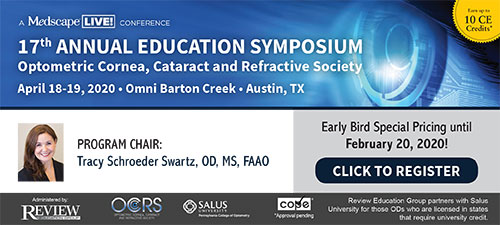 |
||
| Genetic Heritability of Pigmentary Glaucoma and Associations with Other Eye Phenotypes | ||||
Mechanisms behind pigmentary glaucoma, a form of early-onset glaucoma that may potentially lead to severe visual impairment or blindness, are poorly understood. Researchers attempted to calculate the single-nucleotide polymorphism (SNP) heritability of pigmentary glaucoma and identify genetic associations with the disease. This genome-wide association study included affected individuals from Germany and control participants from the United Kingdom. Genome-wide information was obtained for patients with pigmentary glaucoma and control participants free of glaucoma by using the Illumina Human Omni Express Exome 8 v1.2 chip and genomic imputation. The SNP heritability of pigmentary glaucoma was estimated through a restricted maximum likelihood analysis. Associations between the genetic variants, and pigmentary glaucoma obtained from age, sex and principal component-adjusted logistic regression models were compared with those of SNPs previously associated with other eye phenotypes using Pearson product-moment correlations. Data were collected from November 2008 to January 2018, and analysis was completed between April 2018 and August 2019. An estimate of SNP-explained heritability for pigmentary glaucoma; correlations of effect sizes between pigmentary glaucoma, iris pigmentation and myopia; and correlations of effect sizes between pigmentary glaucoma and other eye phenotypes. A total of 227 affected individuals (mean [SD] age, 58.7 [13.3] years) and 291 control participants (mean [SD] age, 80.2 [4.9] years) were included; all were of European ancestry. The SNP heritability of pigmentary glaucoma was 0.45. Twelve SNPs previously reported with genome-wide significant associations with eye pigmentation were associated with pigmentary glaucoma's SNP heritability (4.9% SNP heritability). Pigmentary glaucoma SNP effect sizes were correlated moderately for myopia and more strongly with those for iris pigmentation, although this was nonsignificant per a strict adjusted significance threshold. These findings supported the conclusion that pigmentary glaucoma may have a genetic basis and be highly heritable. Variants associated with lighter eye color and myopia appear to be associated with increased risk of pigmentary glaucoma, but no shared genetic basis with primary open-angle glaucoma (or its quantitative endophenotype of cup-disc ratio) was observed. |
||||
SOURCE: Simcoe MJ, Weisschuh N, Wissinger B, et al. Genetic heritability of pigmentary glaucoma and associations with other eye phenotypes. JAMA Ophthalmol. 2020; Jan 30. [Epub ahead of print]. |
||||
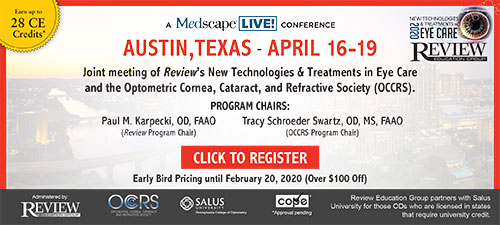 |
||
| News & Notes | ||||||||
| B+L and Prevent Blindness Raise Awareness for AMD Awareness Month s Bausch + Lomb and Prevent Blindness are collaborating this month for the fifth consecutive year to raise awareness about age-related macular degeneration. Throughout February, Bausch + Lomb and Prevent Blindness are posting a variety of content on their social media pages to share facts and information about AMD with the public. Bausch + Lomb will also donate $1 (up to $50,000 through Feb. 29) to Prevent Blindness and its sight-saving fund for every “share” or “like” of certain posts that promote this donation from the Bausch + Lomb SightMatters Facebook page, at https://www.facebook.com/SightMattersCommunity The companies also encourage people to visit SightMatters.com, an educational online resource that Bausch + Lomb created to help people with AMD better understand the condition and its progression. Read more. |
||||||||
| Prevent Blindness Issues Call for Nominations for Awards Prevent Blindness issued a call for nominations for the 2020 Jenny Pomeroy Award for Excellence in Vision and Public Health, and the new Rising Visionary Award. Both awards will be formally presented at the Ninth Annual Prevent Blindness Focus on Eye Health National Summit at the National Press Club in Washington, DC, on July 15, 2020. The Jenny Pomeroy Award for Excellence in Vision and Public Health recognizes an individual, team or organization that has made significant contributions to the advancement of public health related to vision and eye health at the community, state, national and/or international level. Read more. |
||||||||
| BostonSight Partners with Eaglet Eye BostonSight announced a partnership with Eaglet Eye that involves the newly available image-guided feature from BostonSight Scleral: Scleral-IG. This new partnership elevates fitting and ordering scleral lenses for practitioners by integrating a direct connection between Eaglet ESP and FitConnect, BostonSight’s web-based lens design and order management platform to simplify and enhance the practitioner’s experience while driving efficiency in the workflow. |
||||||||
|
||||||||
|
Optometric Physician™ (OP) newsletter is owned and published by Dr. Arthur Epstein. It is distributed by the Review Group, a Division of Jobson Medical Information LLC (JMI), 11 Campus Boulevard, Newtown Square, PA 19073. HOW TO ADVERTISE |


